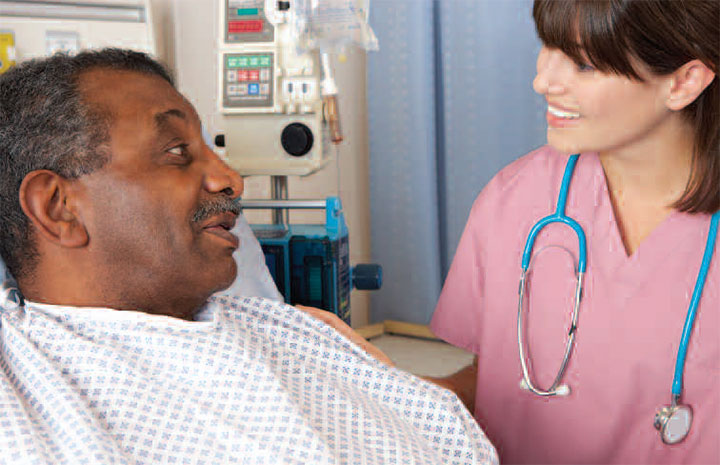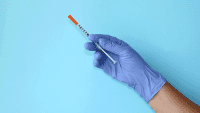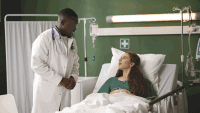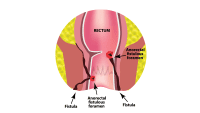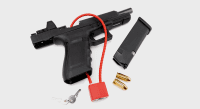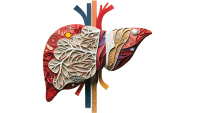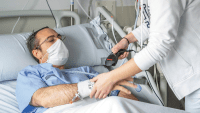Nursing care is key to pressure injury prevention.
Takeaways:
- Support surfaces help reduce intense pressure
- Turning is critical to reducing pressure duration
Pressure injuries (PIs) are a serious complication of immobility, and they’re a nursing quality standard. Insurers no longer reimburse for PIs that occur after hospital admission, and in some states, a full-thickness PI that develops during a hospital stay is reportable to the board of health.
The mission is clear—organizations must prevent PIs. If a PI occurs, early identification is key to prompt treatment. As the healthcare professionals closest to the patient, nurses are critical to achieving this mission. This article focuses on patients on medical-surgical units.
Pathways to PI
PIs occur through two pathways: short periods of time with high pressures and longer periods with lower pressures.
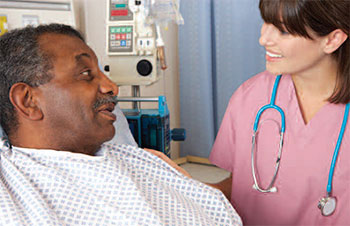

Another situation in which injury can occur quickly is pressure from a medical device—a problem that’s becoming more common as a result of the forms of plastic used in these devices. For example, placing a noninvasive pressure mask over the poorly padded tissue on the bridge of the nose can easily lead to damage.
In other cases, patients may be on a foam or alternating air support surface, so pressure isn’t as high against the soft tissue. But these patients also can develop PIs over time because of prolonged tissue ischemia. According to the National Pressure Ulcer Advisory Panel (NPUAP), a stage 1 PI has intact skin with a localized area of nonblanchable erythema, but you won’t initially see the color changes evident with deep-tissue PI. If ischemia continues, tissue destruction and deformation, along with color changes, will occur. (For a description of all the NPUAP stages.)
You can help prevent PIs by following three evidence-based practice steps.
Determine risk level
Medical-surgical patients at high risk for PIs include those with confusion, malnutrition, or limited mobility (bed- or chair-bound). To best assess risk level, use a reliable tool such as the Braden Scale for Predicting Pressure Sore Risk. The Braden scale measures the impact of six subscales: sensory perception (ability to respond meaningfully to pressure-related discomfort), moisture, activity, mobility, nutrition, and friction and shear. You’ll score patients in each category, and then add the category scores to establish the overall risk assessment—mild, moderate, high, or severe.
The areas of risk described by the Braden tool subscales are generally modifiable with nursing interventions, so you can use them to create a plan of care. For example, you might establish a schedule for turning an immobile patient every 2 hours or recommend enteral feeding for a patient with nutritional deficits. These types of care plans help reduce PI rates because the interventions target the areas of risk.
Keep in mind that the Braden Scale doesn’t accurately predict PI in children, critically ill patients, or in patients going into surgery. Instead, use the Braden QD Scale for children, and keep in mind that nearly all PIs that develop in children are caused by medical devices. Two scales that have been used for the operating room are the Scott Triggers Tool and the Munro Pressure Ulcer Risk Scale, although both require further study.
Reduce pressure
Reducing the risk of PI stems from its two etiologies. Examine the source of pressure and determine how it can be reduced based on whether the patient can move or be moved. If the pressure is high and the patient can’t be moved, choose an appropriate support surface (alternating pressure and low air loss) for the bed or chair, or pad the high-risk areas with foam dressings.
In some patients with deep tissue PIs, the risk can’t be prevented. For example, a patient who falls and breaks a hip or suffers a stroke and is found on the kitchen floor experiences very intense, unavoidable pressure before arriving on the medical-surgical unit. In contrast, a patient who’s going to have a long operation is at high-risk for PI because he or she can’t be moved during surgery, but we can reduce pressure intensity with support surfaces and padding.
Patients exposed to low-intensity, long-duration pressures should be turned to allow for reperfusion of ischemic soft tissue. Traditionally, turning frequency is every 2 hours, but this time frame isn’t ideal for all patients and depends on the surface, bed, or chair. (See Proper turning.) If the patient is conscious and able to move in bed from side to side, encourage him or her to turn off the back every few hours. The lactic acid that collects in the tissue will trigger chemoreceptors in the brain, causing pain that signals the patient to move.
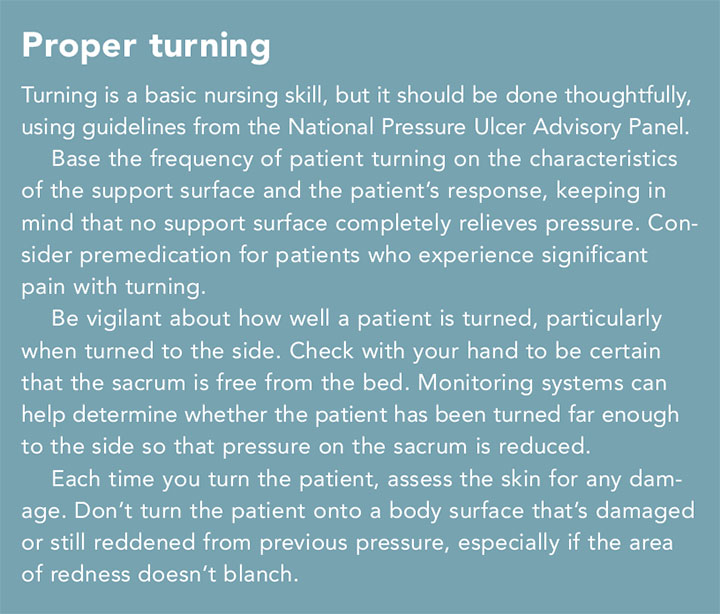

Chair-bound patients who are stable while standing, including older patients who sit in recliners for hours and wheelchair-dependent patients, should stand and march in place for about five steps every hour. Patients who can’t stand because of musculoskeletal or neurologic disability should be repositioned into a correct posture every hour while sitting in a chair.
Improve pressure tolerance
Sometimes, two patients with the exact same exposure to pressure may not both result in PIs. The lack of injury is related to soft-tissue tolerance to pressure. Tolerance improves when soft tissue is intact, well-perfused, well-padded, and at normal temperature and moisture levels.
Ischemia, which can lead to PIs, won’t quickly reverse in patients with peripheral vascular disease, even when pressure is relieved. The oxygen debt continues to climb, and the tissue dies. Ischemic limbs, which will be pale or cyanotic and have weak or absent pulses, thin hairless skin, and thick toenails, need protection from pressure. The heels are the most common area at risk in these patients, so float the legs from the bed surface with heel-offloading devices (boots) or foam dressings. Using a pillow to float the heel off the bed can work if the patient doesn’t move and the pillow doesn’t collapse under the weight of the leg.
PIs are common over bony prominences because these areas of the body lack padding from adipose tissue. Malnourished patients lack padding throughout the body and develop PIs quickly. In addition, malnourished patients don’t heal easily. To reduce pressure in these patients, use a support surface that allows them to immerse into it. Turn malnourished patients frequently and make sure that padding is placed between the knees and ankles. Also, be sure the patient has a nutritional consult to help ensure he or she receives necessary nutrients.
Warm moist skin or skin damaged from exposure to moisture increases the risk of PI. The outer layer of skin absorbs urine and sweat, which leads to macerated skin that’s tacky and doesn’t glide on linens. Diarrhea burns the skin and produces significant injury. Remove any urine, sweat, or stool quickly and moisturize the skin with topical skin products. Use products, such as dimethazone, zinc, and petrolatum, to prevent body fluids from damaging the skin with the next episode of incontinence.
Skin with a prior injury, especially an earlier PI that’s healed with scar tissue, can’t tolerate pressure. Scar tissue is much less elastic than native skin; when it’s stretched it can open. The resulting injury may be a new, recurrent, or reopened injury, depending upon the time since the original injury and the degree of healing that’s occurred.
Prevention success
PI is preventable in most patients. Accurate risk assessments and a plan of care that reduces the intensity and duration of pressure are key to prevention.
Joyce Black is a professor at the University of Nebraska Medical Center College of Nursing—Omaha Division.
Selected references
Black J, Berke C, Urzendowski G. Pressure ulcer incidence and progression in critically ill subjects: Influence of low air loss mattress versus a powered air pressure redistribution mattress. J Wound Ostomy Continence Nurs. 2012;39(3): 267-72.
Black J, Kalowes P. Medical device-related pressure ulcers. Chronic Wound Care Manage Res. 2016;3:91-9.
Cox J. Pressure injury risk factors in adult critical care patients: A review of the literature. Ostomy Wound Manage. 2017;63(11):30-43.
Curley MAQ, Hasbani NR, Quigley SM, et al. Predicting pressure injury risk in pediatric patients: The Braden QD Scale. J Pediatr. 2018;192:189-95.
Gadd MM, Morris SM. Use of the Braden Scale for pressure ulcer risk assessment in a community hospital setting: The role of total score and individual subscale scores in triggering preventive interventions. J Wound Ostomy Continence Nurs. 2014;41(6):535-8.
He W, Liu P, Chen HL. The Braden Scale cannot be used alone for assessing pressure ulcer risk in surgical patients: A meta-analysis. Ostomy Wound Manage. 2012;58(2):34-40.
Kalowes P, Messina V, Li M. Five-layered soft silicone foam dressing to prevent pressure ulcers in the intensive care unit. Am J Crit Care. 2016;25(6):e108-19.
National Pressure Ulcer Advisory Panel, European Pressure Ulcer Advisory Panel and Pan Pacific Pressure Injury Alliance.
Prevention and Treatment of Pressure Ulcers: Quick Reference Guide. Emily Haesler (Ed.). Cambridge Media: Osborne Park, Western Australia; 2014.

